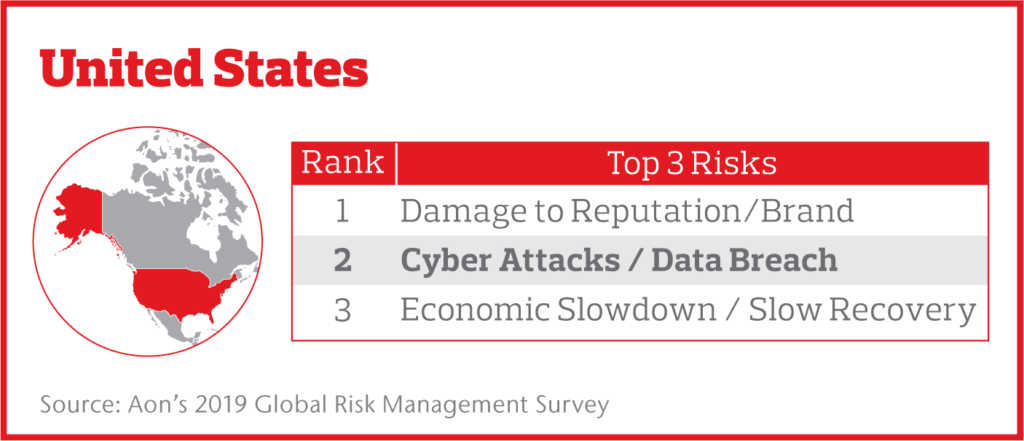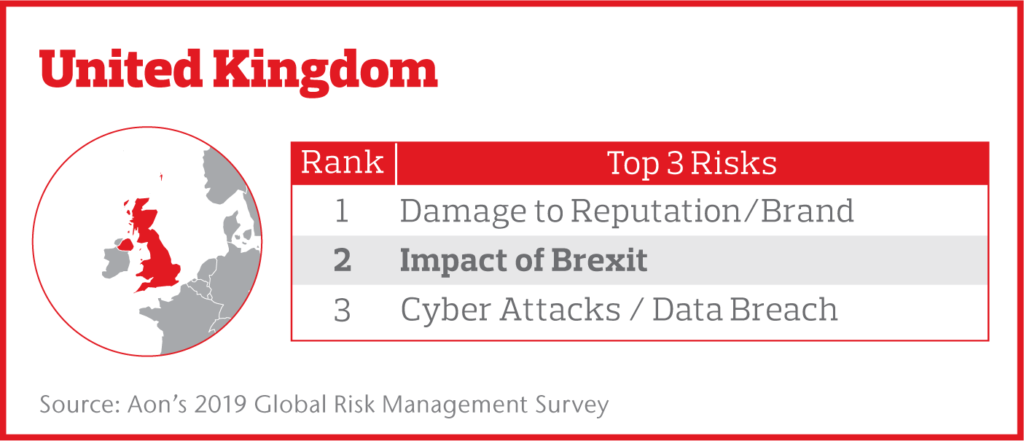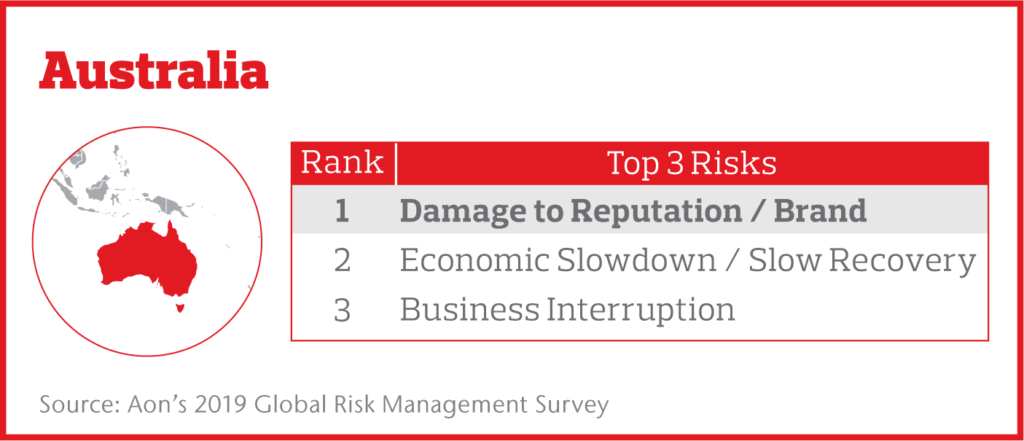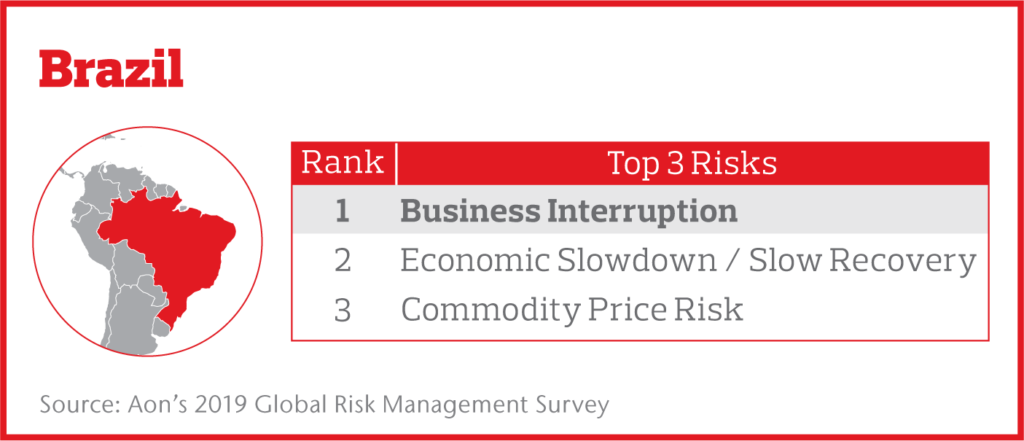OVERVIEW
Geopolitical developments, economic uncertainty and rapid technological advancements create a volatile mix for businesses. And if their organizations are to thrive, executives in the C-suite must navigate the ensuing host of risks.
Often, risks can be interconnected. For example, a cyber attack exposing customers’ personal information can damage a company’s brand. Likewise, disruptive technology that enables new entrants or competitors can change market factors – seemingly overnight.
Among the top risks identified in Aon’s 2019 Global Risk Management Survey (GRMS) are economic slowdown/slow recovery, damage to reputation/brand, accelerated rates of change in market factors, business interruption, increasing competition and cyber attacks/data breaches.
The top risks a company faces might vary by the nature of the business or where it’s located – as well as where its top suppliers, partners and customers are located.
However, awareness of global business risks is more important now than ever before. Indeed, economies are becoming increasingly intertwined – and not just for multinational organizations. For example, reliance on raw materials can lead to even local companies joining the global marketplace.
That said, executives in major hubs in each region have risks in common, with varying interconnectedness.
IN DEPTH
Although many risks are common to businesses around the world, their impact can differ by country.
In The U.S., Cyber Risks Are A Major Concern
While cyber attacks/data breaches were the sixth-ranked risk overall in this year’s GRMS, it was top ranked by North American respondents and ranked second by U.S. respondents.

Technological advances and a connected world are making the exchange of information much easier, allowing ever-greater use of data and opening new opportunities to businesses. Those advances also increase the threat of cyber crime, however. On average, the Ponemon Institute estimates losses of $3.86 million per data breach, globally. And for U.S. organizations, that cost jumps to $7.91 million per breach.
Stephanie Snyder, senior vice president and commercial strategy leader of Cyber Solutions at Aon, notes that today’s reliance on technology has turned virtually every business into a technology business. And as that reliance on technology grows, so does the importance of cyber risks. “It will no longer be a ‘cyber’ risk, but rather an operational risk in which cyber plays a role,” predicts Snyder.
Effectively addressing the cyber threat requires a proactive and comprehensive approach. “From IT to risk management to general counsel, key stakeholders need to be in lockstep to protect the organization,” says Snyder.
Brexit Uncertainty Shapes Risk Perspective With Countries In U.K.
Accelerated rates of change of market factors was the top risk in Europe, particularly regarding U.K. businesses’ concern over the impact of Brexit, and political uncertainty clearly fits.

The Brexit risk also connects to the risk of economic slowdown for U.K. businesses.
“The impasse over Brexit has led to unexpected and unpredictable market forces, which are creating long-term volatility in the equity and commodity markets while also eroding consumer confidence, hampering investment and stalling new product development,” says Julie Page, chief executive officer at Aon U.K. Ltd. “Therefore, it is not surprising that the impact of Brexit and the connected risk of a broader economic slowdown feature as prominent risks for U.K. companies.”
While Brexit continues generating uncertainty, companies that are best prepared for any impact are looking across their organizations to identify both potential risks and also possible opportunities for new markets or products.
“The companies that have assembled broader Brexit task forces are the better prepared ones because they’re putting more thought and more effort into it,” says Ciara Jackson, director of Agri-Food & Beverage at Aon in Ireland. “Those companies are looking at Brexit as the key emerging risk on their register and identify Brexit as high impact, high severity.”
In Singapore, Cash Flow And Liquidity Risk Rises To The Top

Singapore’s top risk is cash flow/liquidity risk, which is interconnected with its third risk, economic slowdown/slow recovery.
Cash flow and liquidity risks – that is, the possibility that an organization might be unable to raise the cash needed to meet short- or medium-term obligations – can emerge from a variety of sources. Unplanned reductions in revenue, business disruptions, delayed customer payments, capital expenditures, increased operational costs, debt repayments and breached loan covenants can all interfere with cash flow and liquidity.
“Regulatory pressures and shifting lender strategies globally are likely driving forces for cash flow and liquidity being identified as the top risk as the top risk in Singapore,” says Steve Taylor, head of Credit Solutions Asia at Aon. “In addition, the negative risk outlook may be influencing lender appetite based on predicted trade flows and default rates. Corporations may be seeing reduced access to traditional sources of capital as a consequence.”
Small and medium-size enterprises are vital to Singapore’s economy: they are responsible for two-thirds of all employment, according to the Singapore Department of Statistics. Still, many face cash flow and liquidity risks that can hinder their growth or even devastate the organization after a major financial loss.
“Working capital is the lifeblood of business, and liquidity is a critical metric and indicator of a corporation’s ability to meet short-term liabilities,” says Taylor. “Increasing cash flow gives companies options – to reinvest, increase dividends, reduce debt or repurchase shares. Credit insurance and guarantee solutions can be used to improve working capital.”
Organizations can address the exposure to this risk by optimizing financial structures and ensuring they have appropriate insurance and financial protections in place to reduce cash flow and liquidity risk exposures.
Australian Businesses See Damage To Reputation/Brand As The Top Risk
A 24/7 news cycle and the global reach of social media mean a negative event can quickly become a threat to a company’s reputation or brand.

Australian business leaders were consistent with their counterparts from across the Asia–Pacific region in citing damage to reputation/brand as the top-ranked risk. Among the reputation risk events making headlines recently in the region were the following:
• results of the Australia Royal Commission into Misconduct in the Banking, Superannuation and Financial Services Industry
• charges by the U.S. Department of Justice against Chinese electronics giant Huawei for violating U.S. sanctions against Iran
• financial misconduct charges in Japan facing former Nissan Chairman Carlos Ghosn
Companies need to take brand value seriously and prepare to move quickly to protect themselves in the face of reputation threats. “Companies work tirelessly to build brands and cultivate positive reputations. Whether they themselves are responsible for the [crisis] event or not, they are the ones responsible for how they respond to it,” says James Baum, chief executive officer at Aon in Australia.
“Reputation risk management must be a top-down priority, and the effort should be embraced across the organization,” adds Randy Nornes, enterprise client leader at Aon. Companies that take such an approach will be best positioned to preserve and even increase shareholder value when a crisis occurs.
Potential For Disruptive External Events Elevates Business Interruption Concern In Brazil
Businesses in Brazil, like those elsewhere in Latin America, are at particular risk from external events that cause business interruption – such as social and political instability, environmental catastrophes and cyber attacks. All of these events can result in significant financial losses for a business.

Manmade disruptions such as political protests or labor strikes can cripple businesses and transportation systems, threatening business continuity and supply chains. Meanwhile, the threat of cyber attacks can disrupt the ability to do business – another example of interconnected risks.
“Businesses must identify the real risks they might face, their biggest vulnerabilities and the extent of potential losses and use that information take specific steps to protect themselves from the risk,” says Guillermo Alvarez, chief broking officer at Aon for Latin America.
Top Risks May Vary, But Addressing Them Successfully Involves Common Elements
While top risks diverge around the world, risk itself is a constant. And awareness is the first step to protecting against them.
As risks continue to evolve and the world becomes more volatile for business, organizations in every region fare best with a cross-organizational – rather than a siloed – view toward managing risk. They also should employ data and analytics whenever possible to make the best risk management decisions and stay a step ahead of the evolving risk landscape.
You can hear more from Aon thought leaders live about these and other top risks at the 2019 Aon Insights Series in London, Melbourne and Singapore.
See how risks have evolved since Aon’s 2017 Global Risk Management Survey.
The post World Tour: Top Risks Across 5 Countries And How They’re Connected appeared first on The One Brief.
